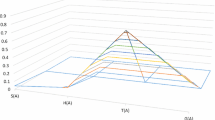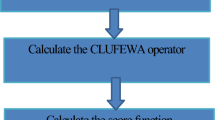Abstract
Different complex fuzzy sets are reported in the literature as the generalizations of fuzzy sets. Complex cubic fuzzy sets are also among those complex fuzzy sets, extensions of cubic sets. The main task is using complex cubic fuzzy sets in decision-making problems, and we propose some aggregation operators. We introduce the concept of complex cubic fuzzy ordered and hybrid weighted averaging operators using Einstein’s sum, product, scalar, and exponential multiplication. We discuss some algebraic operations of complex cubic fuzzy sets (CCFS) and their structural properties. We develop three arithmetic averaging operators: complex cubic fuzzy Einstein weighted averaging (CCFEWA), complex cubic fuzzy Einstein ordered weighted averaging (CCFEOWA), and complex cubic fuzzy Einstein hybrid weighted averaging (CCFEHWA) operators. The CCFEHWA operator generalizes both the CCFEWA and CCFEOWA operators. We apply the CCFEHWA operator to multiple attribute decision-making with complex cubic fuzzy data. In the end, we discuss a numerical example with comparative analysis.
Similar content being viewed by others
Data Availability
No data were used to support this study.
References
Zadeh L. Fuzzy sets. Inf Control. 1965;8:338–53.
Atanassov K. Intuitionistic fuzzy sets. Fuzzy Sets Syst. 1986;20:87–96.
Torra V. Hesitant fuzzy sets. Int J Intell Syst. 2010;25:529–39.
Cornelis C, Deschrijver G, Kerre E. Advances and challenges in interval-valued fuzzy logic. Fuzzy Sets Syst. 2006;157:622–7.
Liu P, Wang P. Some q-rung orthopair fuzzy aggregation operators and their applications to multiple-attribute decision making. Int J Intell Syst. 2018;33:1–22.
Yager R. Pythagorean membership grades in multi- criteria decision making. IEEE Trans Fuzzy Syst. 2014;22:958–65.
Jun K. Chang Su Kim, “Cubic sets.” Ann Fuzzy Math Inform. 2012;4:83–98.
Ramot D, Milo R, Friedman M, Kandel A. Complex fuzzy sets. Fuzzy Systems IEEE Transactions on. 2002;10:171–86.
Xu Z, Yager R. Some geometric aggregation operators based on intuitionistic fuzzy sets. Int J Gen Syst. 2006;35:417–33.
Xu Z. Intuitionistic fuzzy aggregation operators. IEEE Trans Fuzzy Syst. 2013;15:1179–87.
Li D. Multi-attribute decision making method based on generalized OWA operators with intuitionistic fuzzy sets. Expert Syst Appl. 2010;37:8673–8.
Xu Z. Approaches to multiple- attribute group decision making based on intuitionistic fuzzy power aggregation operators. Knowl-Based Syst. 2011;24:749–60.
Zhao X, Wei G. Some intuitionistic fuzzy Einstein hybrid aggregation operators and their application to multiple- attribute decision making. Knowl-Based Syst. 2013;37:472–9.
Xu Z, Xia M. Distance and similarity measures for hesitant fuzzy sets. Information ences. 2011;181:2128–38.
Zhang N, Wei G. Extension of VIKOR method for decision making problem based on hesitant fuzzy set. Appl Math Model. 2013;37:4938–47.
Wei G, Lin R, Wang H. Distance and similarity measures for hesitant interval-valued fuzzy sets. Journal of Intelligent & Fuzzy Systems. 2014;27:19–36.
Xu Z, Xia M, Chen N. Some hesitant fuzzy aggregation operators with their application in group decision making. Group Decis Negot. 2011;22:259–79.
Vahdani B, Hadipour H, Sadaghiani J, Amiri M. Extension of VIKOR method based on interval-valued fuzzy sets. Int J Adv Manuf Technol. 2010;47:1231–9.
Xu Y, Shang X, Wang J, Zhao H, Zhang R, Bai K. Some interval valued q-rung dual hesitant fuzzy Muirhead mean operators with their application to multi-attribute decision-making. IEEE Access. 2019;7:54724–45.
Liu P, Wang P. Multiple-attribute decision-making based on Archimedean Bonferroni operators of q-rung orthopair fuzzy numbers. IEEE Trans Fuzzy Syst. 2019;5:834–48.
Zhang X, Xu Z. Extension of TOPSIS to multiple criteria decision making with Pythagorean fuzzy sets. Int J Intell Syst. 2015;29:1061–78.
Liu P, Wang P. Multiple-attribute decision-making based on Archimedean Bonferroni operators of q-rung orthopair fuzzy numbers. IEEE Trans Fuzzy Syst. 2019;27:834–48.
Zhang Q, Hu J, Feng J, Liu A. Multiple criteria decision making method based on the new similarity measures of Pythagorean fuzzy set. Journal of Intelligent and Fuzzy Systems. 2020;8:1–12.
Ali M, Deli I, Smarandache F. The theory of neutrosophic cubic sets and their applications in pattern recognition. Journal of Intelligent & Fuzzy Systems. 2016;30:1957–63.
Sethi N. Probabilistic interpretation of complex fuzzy set. International Journal of Computer science Engineering & Informa. 2012;2:31–44.
Ramot D, Friedman M, Langholz G, Kandel A. Complex fuzzy logic. IEEE Trans Fuzzy Syst. 2003;11:450–61.
Dick S, Yager R, Yazdanbakhsh O. On Pythagorean and complex fuzzy set operations. IEEE Trans Fuzzy Syst. 2016;24:1009–21.
Zhang G, Dillon T, Cai K, Ma J, Lu J. Operation properties and delta-equalities of complex fuzzy sets. Int J Approximate Reasoning. 2009;50:1227–49.
Al-Qudah Y, Hassan N. Operations on complex multi-fuzzy sets. Journal of Intelligent & Fuzzy Systems. 2017;33:1527–40.
Rani D, Garg H. Distance measures between the complex intuitionistic fuzzy sets and its applications to the decision-making process. Int J Uncertain Quantif. 2017;7:423–39.
Garg H, Rani D. Some generalized complex intuitionistic fuzzy aggregation operators and their application to multicriteria decision-making process. Arab J Sci Eng. 2018;44:2679–98.
Bi L, Hu B. Complex fuzzy geometric aggregation operators. Symmetry. 2018;10:1–14.
Liu L, Zhang X. Comment on Pythagorean and complex fuzzy set operations. IEEE Trans Fuzzy Syst. 2018;26(6):3902-4.
Al-Qudah Y, Hassan N. Complex multi-fuzzy soft expert set and its application. International Journal of Mathematics and Computer ence. 2019;14:149–76.
Garg H, Rani D. Robust averaging–geometric aggregation operators for complex intuitionistic fuzzy sets and their applications to MCDM process. Arab J Sci Eng. 2019;45:2017–33.
Ullah K, Mahmood T, Ali Z, Jan N. On some distance measures of complex Pythagorean fuzzy sets and their applications in pattern recognition. Complex & Intelligent Systems. 2019;6:15–27.
Garg H, Rani D. A robust correlation coefficient measure of complex intuitionistic fuzzy sets and their applications in decision-making. Appl Intell. 2019;49:496–512.
Ali Z, Mahmood T. Maclaurin symmetric mean operators and their applications in the environment of complex q-rung orthopair fuzzy sets. Comput Appl Math. 2020;39:1–27.
Garg H, Rani D. Robust averaging-geometric aggregation operators for complex intuitionistic fuzzy sets and their applications to MCDM process. Arabian Journal for ence and Engineering. 2020;45:2017–33.
Fahmi A, Amin F, Smarandache F, Khan M, Hassan N. Triangular cubic hesitant fuzzy Einstein hybrid weighted averaging operator and its application to decision making. Symmetry. 2018;10(11):658.
Fahmi A, Abdullah S, Amin F, Ali A, Khan WA. Some geometric operators with triangular cubic linguistic hesitant fuzzy number and their application in group decision-making. Journal of Intelligent & Fuzzy Systems. 2018;2:2485–99.
Mehmood F, Mahmood T, Khan Q. Cubic hesitant fuzzy sets and their applications to multicriteria decision making. International Journal of Algebra and Statistics. 2016;5:19–51.
Amin F, Fahmi A, Abdullah S, Ali A, Ahmad R, Ghani F. Triangular cubic linguistic hesitant fuzzy aggregation operators and their application in group decision making. J Intell Fuzzy Syst. 2018;34:2401–16.
Fahmi A, Amin F, Abdullah S, Ali A. Cubic fuzzy Einstein aggregation operators and its application to decision-making. Int J Syst Sci. 2018;49(11):2385-97.
Abbas S, Khan M, Abdullah S, Sun H, Hussain F. Cubic Pythagorean fuzzy sets and their application to multi-attribute decision making with unknown weight information. J Intell Fuzzy Syst. 2019;37:1–16.
Garg H, Rani D. Generalized geometric aggregation operators based on t-norm operations for complex intuitionistic fuzzy sets and their application to decision-making. Cognit Comput. 2019.
Zhang B, Mahmood T, Ahmmad J, Khan Q, Ali Z, Zeng S. Cubic q-rung orthopair fuzzy Heronian mean operators and their applications to multi-attribute group decision making. Mathematics. 2020;8:1–32.
Abdullah S. Multicriteria group decision-making for supplier selection based on intuitionistic cubic fuzzy aggregation operators. Int J Fuzzy Syst. 2020;22:810-23.
Abdullah S, Aslam M. New multicriteria group decision support systems for small hydropower plant locations selection based on intuitionistic cubic fuzzy aggregation information. Int J Intell Syst. 2020;35(6):983-1020.
Chinnaduri V, Thayalan S, Bobin A. Complex cubic set and their properties. Adv Mat Sci journal. 2020;9:1561–7.
Akram M, Bashir A, Garg H. Decision-making model under complex picture fuzzy Hamacher aggregation operators. Comput Appl Math. 2020;39(3):1–38.
Gulistan M, Yaqoob N, Vougiouklis T, Wahab HA. Extensions of cubic ideals in weak left almost semihypergroups. J Intell Fuzzy Syst. 2019;34(6):4161–72.
Yaqoob N, Gulistan M, Leoreanu-Fotea V, Hila K. Cubic hyperideals in LA-semihypergroups. J Intell Fuzzy Syst. 2018;34(4):2707-21.
Khan M, Jun YB, Gulistan M, Yaqoob N. The generalized version of Jun’s cubic sets in semigroups. Journal of Intelligent & Fuzzy Systems. 2015;28:947–60.
Gulistan M, Khan M, Yaqoob N, Shahzad M, Ashraf U. Direct product of generalized cubic sets in Hv-LA-semigroups. Science International. 2016;28(2):767–79.
Gulistan M, Khan M, Yaqoob N, Shahzad M. Structural properties of cubic sets in regular LA-semihypergroups. Fuzzy Information and Engineering. 2017;9(1):93–116.
Khan M, Gulistan M, Yaqoob N, Hussain F. General cubic hyperideals of LA-semihypergroups. Afr Mat. 2016;27:731–51.
Akram M, Yaqoob N, Gulistan M. Cubic KU-subalgebras. International Journal of Pure and Applied Mathematics. 2013;89(5):659–65.
Ma XL, Zhan J, Khan M, Gulistan M, Yaqoob N. Generalized cubic relations in Hv -LA-semigroups. Journal of Discrete Mathematical Sciences and Cryptography. 2018;21(3):607–30.
Rashid S, Yaqoob N, Akram M, Gulistan M. Cubic graphs with application, International Journal of. Anal Appl. 2018;16(5):733–50.
Gulistan M, Hassan N. A generalized approach towards soft expert sets via neutrosophic cubic sets with applications in games. Symmetry. 2019;11(2):289.
Al Shumrani MA, Gulistan M, Khan S. The neutro-stability analysis of neutrosophic cubic sets with application in decision making problems. J Math. 2020;2020:1-6.
Zhan J, Khan M, Gulistan M, Ali A. Applications of neutrosophic cubic sets in multi-criteria decision-making. Int J Uncertain Quantif. 2017;7(5):377–94.
Gulistan M, Elmoasry A, Yaqoob N. N-version of the neutrosophic cubic set; application in the negative influences of Internet. J Supercomput. 2021;77:11410–31.
Gulistan M, Rashid S, Jun YB, Kadery S, Khan S. N-Cubic sets and aggregation operators. J Intell Fuzzy Syst. 2019;37(4):5009–23.
Greenfield S, Chiclana F, Dick S. Interval-valued complex fuzzy logic. In 2016 IEEE International Conference on Fuzzy Systems (FUZZ-IEEE) 2016 (pp. 2014-2019). IEEE.
Zhou X, Deng Y, Huang Z, Yan F, Li W. Complex cubic fuzzy aggregation operators with applications in group decision-making. IEEE Access. 2020;8:223869-88.
Alkouri A, Salleh A. Complex Atanassov’s intuitionistic fuzzy relation. Abstr Appl Anal. 2013;20:1–18.
Fahmi A, Amin F, Abdullah S, Ali A. Cubic fuzzy Einstein aggregation operators and its application to decision-making. Int J Syst Sci. 2018;49:2385–97.
Zadeh L, Fu K, Tanaka K, Shimura C, Negoita M. Fuzzy sets and their applications to cognitive and decision processes. Systems Man & Cybernetics IEEE Transactions on. 1977;7:122–3.
Wang L, Li N. Pythagorean fuzzy interaction power Bonferroni mean aggregation operators in multiple attribute decision making. Int J Intell Syst. 2020;35(1):150-83.
Author information
Authors and Affiliations
Contributions
All authors contribute equally to the preparation of this manuscript.
Corresponding author
Ethics declarations
Research Involving Human Participants and/or Animals
This article does not contain any studies with human participants or animals performed by any of the authors.
Informed Consent
This article does not contain any studies with human participants performed by any of the authors. So, no need of to provide informed consent.
Conflict of Interest
The authors declare no competing interests.
Additional information
Publisher's Note
Springer Nature remains neutral with regard to jurisdictional claims in published maps and institutional affiliations.
Rights and permissions
Springer Nature or its licensor (e.g. a society or other partner) holds exclusive rights to this article under a publishing agreement with the author(s) or other rightsholder(s); author self-archiving of the accepted manuscript version of this article is solely governed by the terms of such publishing agreement and applicable law.
About this article
Cite this article
Tanoli, M.N.K., Gulistan, M., Amin, F. et al. Complex Cubic Fuzzy Einstein Averaging Aggregation Operators: Application to Decision-making Problems. Cogn Comput 15, 869–887 (2023). https://doi.org/10.1007/s12559-022-10100-9
Received:
Accepted:
Published:
Issue Date:
DOI: https://doi.org/10.1007/s12559-022-10100-9




